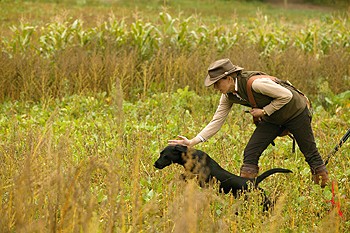Training to take the field

Field trialling appears to have seen a growth in its popularity over recent years, with many clubs being oversubscribed for stakes and trials. While people may have an interest in field trialling, the question remains: how do you actually get enough practice ? both for you and your dog ? to reach a standard where both are good enough to stand a chance of success? Though your dog may handle perfectly well retrieving pigeon from a hide or picking-up on a shoot, competing is a different ball game. A dog that may function like clockwork one-to-one with its handler can go to pieces in front of other dogs and handlers at a trial, or the handler likewise. Coupled with this is the varying nature of the terrain that can be encountered at different trials throughout the UK. A dog used to heather and tussocks may struggle on the beet fields of East Anglia and, similarly, dogs used to open ground may come unstuck when a fence or wall is encountered. All in all, training a dog to be good enough to win any trial, let alone the championships, requires great dedication and can be fraught with logistical problems.
One answer to this is the training days being offered on shoots, such as Mike Appleby?s Honeycombe shoot, near Sherborne, in Dorset. Mike and his partner Antonia run the shoot mainly on a commercial basis, but they have also set aside an area purely for training dogs. The days Mike runs are walked-up days among a wide mixture of crops, ranging from open ground with chickweed, stubble turnip and kale, to denser patches of sunflowers, sorghum, maize and quinoa. Thus, novice dogs can see a retrieve where it falls, but in the denser ground they need the handler to do some of the work. The ground is crossed with fences to aid jumping skills and the quarry is partridge and pheasant with the chance of a rabbit or two. Mike also has patches of woodland available to handlers if these are required. It is perhaps like a field-trial ground in miniature.
On the day I visited there were four Guns in the line and nine handlers. Overseeing the line was Mike Appleby and George Newman. Looking after the handlers was the jovial Somerset-based trainer David Raynor. Both Mike and David stressed that it was a training day where, in their own time, handlers could assess weak spots in themselves and their dogs and practise different retrieves without any pressure. One of the problems that Mike highlighted was handlers sending their dogs too soon. This can lead to dogs developing the habit of running-in. With the amount of game available it was also a useful opportunity for dogs to get used to the scent of the shot bird and ignore the others.
Some of the handlers had come from as far as Brighton and Kent for their day, which is possibly an indication of how difficult it can be to find ground for dog training in local areas. As one lady handler pointed out, many women enjoy working their dogs but do not actually shoot, making it even harder to get in enough practice. As the vast majority of field trial championships ? whether retriever or spaniel ? are walked-up, a day leisurely walking-up game is ideal.
One of the most popular ways of training spaniels has been rabbit shooting in the north of England. However, I understand that the previous hard winter seriously affected rabbit populations, so it will be interesting to see how this has affected training. However, knowing the fecundity of the rabbit, I can?t see them being absent for too long.
Mike keepers the shoot as well as running it and as such has seen all sorts of dogs come and go among the Guns and beaters. He said: ?There was a demand and a market for different ground to set up different situations for dogs that they might encounter on a shoot day or trial. There was a lot of interest from different parties, so I decided to set the days up. Some groups come as a unit with Guns, handlers and a trainer, but individuals are welcome as well. If handlers have no trainer available, one can be provided for the day. We are at our busiest in September and October, as Guns and triallers want their dogs ready for the season. However, we can run days throughout the shooting season, cater for all breeds and can lay on falconry days as well.?
I asked Mike what the main problems are with dogs that he comes across. ?Excitement is a problem and, while the dog may behave well with its owner, there are temptations for a dog on a shoot day or at a trial,? he told me. ?Dogs can run-in or chase game and getting them steady is one of the key factors.?
All in all, it was an enjoyable, unhurried day and gave all the dogs and handlers plenty of opportunities for retrieves. It was also a chance for Guns and handlers to brush up on their marking skills and, where trialling is concerned, marking the fall of game is one of the most vital skills.
If you would like more information on training days on the Honeycombe shoot, email Mike or Antonia at [email protected].








